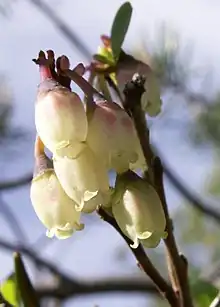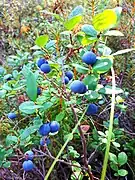Vaccinium uliginosum
Vaccinium uliginosum (bog bilberry, bog blueberry,[2] northern bilberry or western blueberry[3]) is a Eurasian and North American flowering plant in the genus Vaccinium within the heath family.
| Vaccinium uliginosum | |
|---|---|
 | |
 | |
| Scientific classification | |
| Kingdom: | Plantae |
| Clade: | Tracheophytes |
| Clade: | Angiosperms |
| Clade: | Eudicots |
| Clade: | Asterids |
| Order: | Ericales |
| Family: | Ericaceae |
| Genus: | Vaccinium |
| Species: | V. uliginosum |
| Binomial name | |
| Vaccinium uliginosum | |
| Synonyms[1] | |
| |
Distribution
Vaccinium uliginosum is native to cool temperate regions of the Northern Hemisphere, at low altitudes in the Arctic,Baltics, and at high altitudes south to the Pyrenees, the Alps, and the Caucasus in Europe, the mountains of Mongolia, northern China, the Korean Peninsula and central Japan in Asia, and the Sierra Nevada in California and the Rocky Mountains in Utah in North America.[4][5][6][7]
It grows on wet acidic soils on heathland, moorland, tundra, and in the understory of coniferous forests, from sea level in the Arctic, up to 3,400 metres (11,200 ft) altitude in the south of the range.
Description
Vaccinium uliginosum is a small deciduous shrub growing to 10–75 cm (4–30 in) tall, rarely 1 m (3 ft 3 in) tall, with brown stems (unlike the green stems of the closely related bilberry). The leaves are oval, 4–30 mm (5⁄32–1+3⁄16 in) long and 2–15 mm (5⁄64–19⁄32 in) wide, blue-green with pale net-like veins, with a smooth margin and rounded apex.[4]
The flowers are pendulous, urn-shaped, pale pink, 4–6 mm (5⁄32–15⁄64 in) long, produced in mid spring. The fruit is a dark blue-black berry 5–8 mm (3⁄16–5⁄16 in) diameter, with a white flesh, edible and sweet when ripe in late summer.[4]
Culinary use
The berries can be eaten raw or cooked, used to make jelly or pies, or dried to make pemmican.[8] Bog bilberry is used in infused liquor in Korea.
 Deuljjuk-sul (bog bilberry liquor) and jindallae-sul (Korean rhododendron liquor) produced in North Korea
Deuljjuk-sul (bog bilberry liquor) and jindallae-sul (Korean rhododendron liquor) produced in North Korea Eastern Siberia
Eastern Siberia
References
- "Vaccinium uliginosum". World Checklist of Selected Plant Families. Royal Botanic Gardens, Kew – via The Plant List. Note that this website has been superseded by World Flora Online
- USDA, NRCS (n.d.). "Vaccinium uliginosum". The PLANTS Database (plants.usda.gov). Greensboro, North Carolina: National Plant Data Team. Retrieved 28 July 2015.
- Wallace, Gary D. (2017). "Vaccinium uliginosum subsp. occidentale". In Jepson Flora Project (ed.). Jepson eFlora. The Jepson Herbarium, University of California, Berkeley. Retrieved 18 July 2018.
- Vander Kloet, Sam P. (2009). "Vaccinium uliginosum". In Flora of North America Editorial Committee (ed.). Flora of North America North of Mexico (FNA). Vol. 8. New York and Oxford: Oxford University Press – via eFloras.org, Missouri Botanical Garden, St. Louis, MO & Harvard University Herbaria, Cambridge, MA.
- Fang, Ruizheng; Steven, Peter F. "Vaccinium uliginosum". Flora of China. Vol. 14 – via eFloras.org, Missouri Botanical Garden, St. Louis, MO & Harvard University Herbaria, Cambridge, MA.
- Altervista Flora Italiana, Falso mirtillo, Vaccinium uliginosum L.
- "Vaccinium uliginosum". State-level distribution map from the North American Plant Atlas (NAPA). Biota of North America Program (BONAP). 2014.
- Nyerges, Christopher (2017). Foraging Washington: Finding, Identifying, and Preparing Edible Wild Foods. Guilford, CT: Falcon Guides. ISBN 978-1-4930-2534-3. OCLC 965922681.
Further reading
- Blamey, M.; Grey-Wilson, C. (1989). Flora of Britain and Northern Europe. Hodder & Stoughton.
External links
- Calflora
- Jepson Manual treatment of Vaccinium uliginosum – flora of California.
- Flora Europaea: Vaccinium uliginosum
- Plants of British Columbia: Vaccinium uliginosum
- Vaccinium uliginosum in the CalPhotos photo database, University of California, Berkeley
 Media related to Vaccinium uliginosum at Wikimedia Commons
Media related to Vaccinium uliginosum at Wikimedia Commons